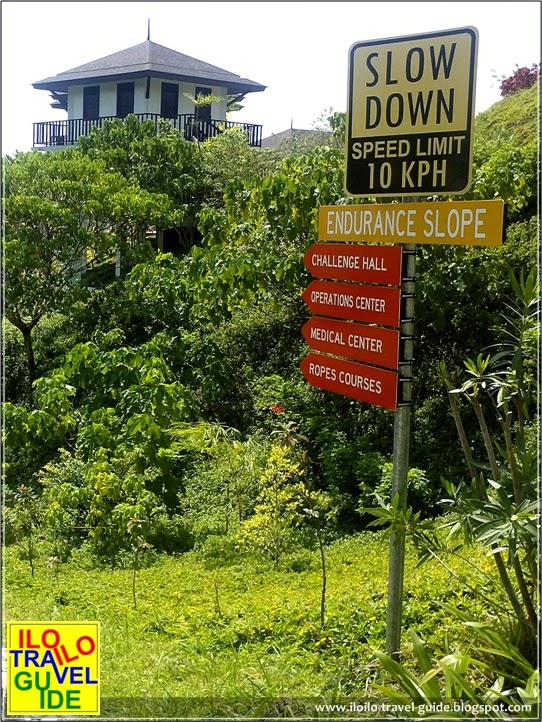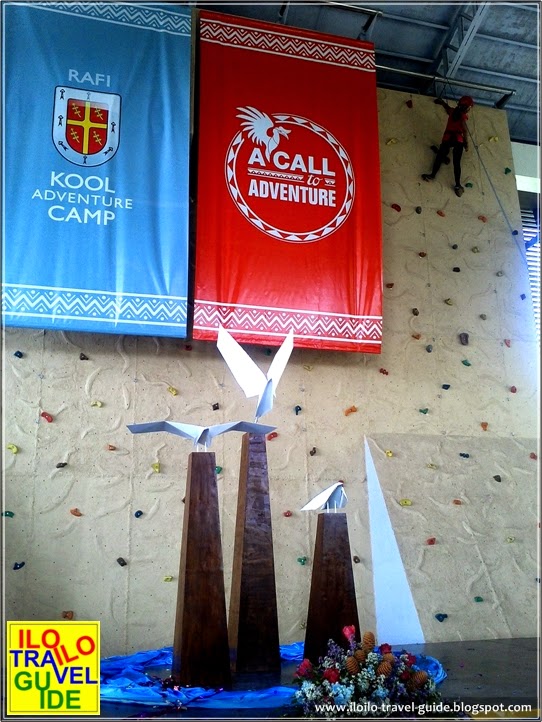The Ramon Aboitiz Foundation Inc.(RAFI) recently inaugurated the first and only fully dedicated Adventure Education Center in the Philippines - Kool Adventure Camp (KAC). Formally opened to the public on August 2, 2014, K.A.C. is located in Brgy. Cansomoroy, Balamban - about an hour's drive west of Cebu City via the Transcentral Highway.
The inauguration ceremony was led by Department of Education Undersecretary for External Linkages Mario Deriquito and Cebu Governor Hilario Davide III together with the Aboitizes and the whole RAFI family.
 |
| Kool Adventure Campers giving the guests a very warm welcome |
A flagship program of RAFI under its Leadership & Citizenship focus area, RAFI-KAC's mission is to equip organizations and individuals with the character, competence and citizenship to be leaders of change, through powerful learning experiences.
Bloggers and media guests from all over Visayas and Mindanao were there not only to cover the inauguration but also toured portions of the the camp and experience what's it like to be a KAC Camper. What sets it aside from other institutions involved in team building and adventure programs is that they are mostly for entertainment and leisure, while KAC is a whole lot more.
RAFI-KAC is a serious attempt to build leadership attributes in the Filipino youth" said RAFI President Roberto “Bobby” Aboitiz. "The Center will offer programs that are designed to be fun, but in purpose to promote self-confidence, trust, optimism, positive attitude, courage, respect for others, and the assumption of one’s responsibility for one’s own future.”
For his part, DepEd Usec. Deriquito lauded RAFI for spending time, effort and resources for coming up with a facility designed to mould the youth.“We need leaders who can inspire others. Such leaders are not born, they are shaped and formed. The KAC is an excellent facility to help develop the foundation for good leaders,” he said.
 |
| Edvan Loh leads the ceremonial opening of K.A.C. |
“The critical first step towards creating real change in the community is the belief and confidence that you can make the difference." said RAFI-KAC Camp Director Edvan Loh. "Through specially designed and facilitated learning experiences, all our campers experience personal empowerment and breakthroughs in what they believe they can achieve,”.
And instead of the usual ribbon cutting or toasting ceremony, the facility's formal opening was marked with adventure - a wall climbing ceremony that ended with a big bang!
A presscon was held after the program giving a more in depth look into how it all began, the current facilities, how it operates, its various programs and more. (Details and photos from www.rafi.or.ph)
The building also serves as the Operations center of the camp and an exhibit hall divided into learning rooms. The medical facility of the entire camp is located at the building complete with an ambulance on stand-by.
For over a decade, the Kool Adventure Camp (KAC) of the Ramon Aboitiz Foundation Inc. (RAFI) has continued to work towards its goal of providing learning and development opportunities for young individuals as well as organizations through experiential education.
The vision started when PECOS River Learning Center, an international outdoor experiential organization, installed the Challenge Ropes Course in Punta Engaño, Lapu-Lapu City, for personal development of Aboitiz executives.
RAFI team leaders and members had the chance to conquer the Challenge Ropes Course for free by PECOS River Learning Center facilitators from Colorado, USA. It was then passed on to RAFI to leverage its application to the foundation’s social development programs.
Bobby Aboitiz conceived the idea of creating a leadership program for public schools using experiential learning through the ropes course.
The pilot camp was participated by student leaders of different schools in Cebu. The first batch of campers tested the program design at the Base Camp, Boys Scout of the Philippines in Nivel Hills, Lahug. The program was officially named as Kool Adventure Camp (KAC). It became RAFI’s youth development program.
The first professional program was participated by RAFI, Penshoppe, Matimco, Madera Foundation, City Savings Bank, and the community organization composed of community leaders of Tabuelan, Balamban, and Tuburan.
In 2010, the budget for the new camp site was approved by the RAFI board. RAFI assembled the camp planning and design team to create the new camp site design. And in 2011 groundbreaking of the KAC new camp site in Cansmoroy, Balamban, Cebu took place.
Roberto “Bobby” Aboitiz, RAFI President and KAC founder, envisioned KAC as an adventure camp program for public schools. Its primary purpose is to enhance the spirit of the individual, with the end goal of producing better people.A tour of (some portions of) the Camp followed starting with the main building where the the event was held. It houses the Challenge Hall which serves as a multipurpose hall at the same time having some indoor challenge rope courses.
“KAC is a leadership program. This is a program to prepare them to be the leaders of today and of the future,” he said.
From a small room in a building to a 10-hectare campsite in Balamban…
 |
| Challenge Hall houses CLUSTER 3 challenge courses |
The nearby grounds has an ampitheatre for various activities that also serves as helipad for medical emergencies
Kool Adventure Camp empowers through the 28 kinds of challenge course high elements. A Challenge Ropes Course (CRC) consists of aesthetically designed series of ropes, cables and wood poles combined in such a way as to simulate challenges that might be found in a natural setting. The CRC is a tool in an experiential education program, offering groups and individuals the opportunity to participate in a series of activities involving mental, physical and emotional risk taking.
 |
| CLUSTER 1: Space walk, Jacob’s ladder, two line bridge, pamper pole, high Y and inclined climbing wall. |
 |
| CLUSTER 2: island in the sky, centipede, Burma bridge, high wild woosey, vertical playpen, quadrophenia, and catwalk. |
CRC programs give individuals the opportunity to increase their communication skills while becoming more resilient in overcoming self imposed limits & fears, while groups learn to be more interdependent and collaborative. Attempting and succeeding in this type of activity often gives one a feeling of accomplishment, self-worth, elation and recognition that seemingly impossible situations are in fact quite possible.
 |
| CLUSTER 4: These iconic structures represents "The Flight" designed by world renowned industrial designer Kenneth Cobonpue includes tandem zip line, sling shot, rappel, and cargo net climb. |
Further into the facility is the camp ground where participants learn the basic of surviving outdoors. They rent or bring their own tents, cook their own food and experience nature at its best. Toilet, bath and wash facilities as well as clean drinking water are provided near the area.
Lunch was served at the community dining hall which was about half kilometer from the Challenge hall. This area is houses the Administration building, conference halls and the tallest portion of the facility - The Summit, where one can get a great view of the whole camp.
As the KAC offers 3-day, 2-night programs, there are accommodation facilities within the camp ground. It can accommodate 300 participants per day and the residential facilities can house 64 participants in the corporate cabins, 156 in the youth bunk and the camp groun around 50 participants.
 |
| Youth bunks |
And when we got to our destination, we were challenged to experience what its like to be a KAC participant.
Those who qualified (we were given forms to fill up and they were assessed by the staff) and accepted the challenge balanced themselves in the air traversing the HOUS bridge (?).
Or got the chance to try climbing the rockwall.
It was really our Call to Adventure that day. For us first timers in this part of Cebu, the travel was already part of it. The really cool facilities of KAC was made even cooler with its very able staff who not only guided us but also made us feel welcome.
With these programs, RAFI-KAC hopes to build the character of the trainees through self-discovery, self-confidence, team awareness, and team values; to improve their competence through communication, leadership, problem solving, and decision making; and to invoke the spirit of citizenship through service learning and personal responsibility and accountability.
For additional informational, please visit www.rafi,org.ph or contact RAFI-KAC at (032) 260-9000 local 1001 or email info.kac@rafi.org.ph. Also check them out on Facebook: Kool Adventure Camp.
The Ramon Aboitiz Foundation Inc. (RAFI) is a non-stock, non-profit development organization serving primarily the Visayas and Mindanao area. Throughout its years of development work, it aims to consistently uphold its vision of “Touching People, Shaping the Future” in the areas of Integrated Development, Micro-finance and Entrepreneurship, Culture and Heritage, Education and Leadership and Citizenship.
The Ramon Aboitiz Foundation Inc. (RAFI) is a non-stock, non-profit development organization serving primarily the Visayas and Mindanao area. Throughout its years of development work, it aims to consistently uphold its vision of “Touching People, Shaping the Future” in the areas of Integrated Development, Micro-finance and Entrepreneurship, Culture and Heritage, Education and Leadership and Citizenship.




















